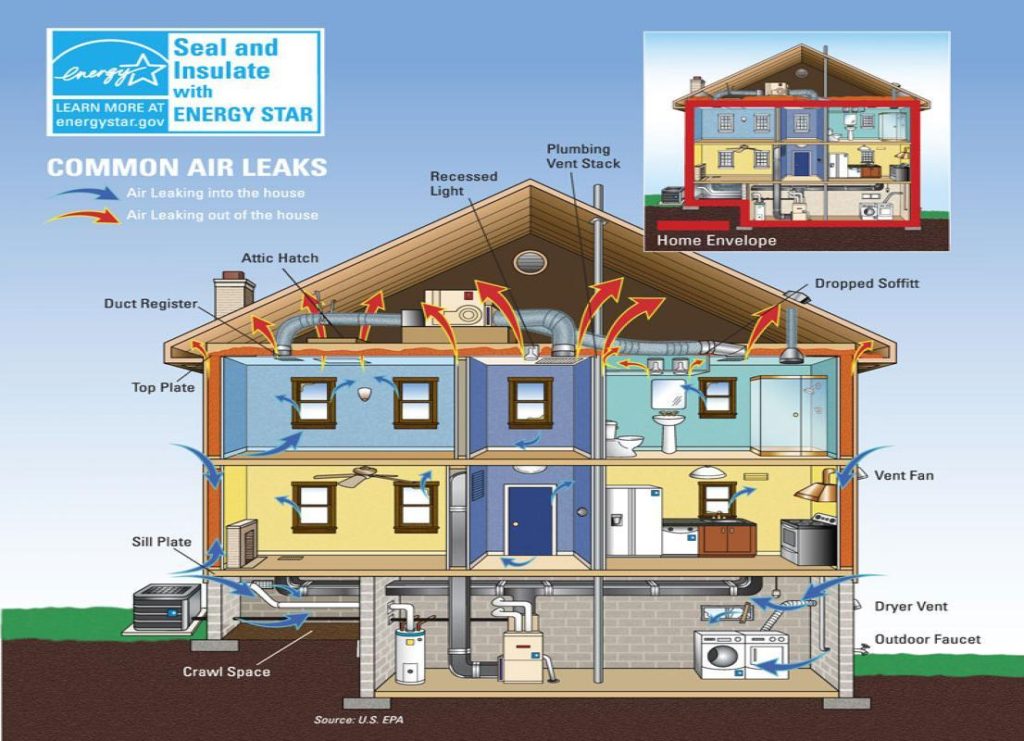

Importance of Air Sealing your Home, Especially Your Attic
Air leakage is a very serious issue in most homes. Air can leak through various parts of the home such as cracked walls, floors, and especially the attic. Most people intentionally let air into their homes for ventilation but this hardly serves the purpose especially if you need controlled ventilation and also improve your indoor air quality. For instance, during less windy weather, the amount of air that may enter the home could be insufficient but too much air may enter the home if the weather condition is windy. Moreover, the indoor air quality in both cases would be poor or suboptimal. To effectively control the amount of air that enters the home and improve the air quality, you need to air seal the home.
What is air sealing?
Air sealing is a process of identifying areas of the home from which air leaks. On identifying these areas of the home, the right air sealing method is applied to patch it off to improve air quality. What part of the home requires air sealing? If you want to properly insulate your home, you should seal any part of the home that allows air to escape. This depends a lot on the type of home you have but the most common areas include the attic, windows and doors, floor, and fireplace.
Why You Need Air Sealing
Air sealing is done mainly to insulate the home, to improve air quality,y and also save energy costs. However, it offers a lot more benefits. Some of the benefits of air sealing will be discussed shortly.
A lot of things can add to your energy cost, and you want to reduce them as much as possible. Your HVAC system will work extra hard to keep your home at an optimal condition if cold or warm outdoor air contaminates the indoor air. When you insulate your home, you will trap warm in within your home during winter and cold air during summer. This will reduce the workload on the HVAC system and therefore minimize the energy cost.
Without proper insulation, your home can feel very uncomfortable during summer and winter. During summer, air leaks can cause your home to feel much warmer and uncomfortable and during winter, you may feel daft if your home is not properly insulated. Air sealing is the easiest way to regulate the temperature of your home.
If you live in a busy city, outdoor noise can easily affect your indoor comfort. Insulating your home is a sure-fire way to improve indoor comfort. Air sealing not only insulate your home from air and dust, but it also prevents noise from getting into your home. It could prevent sounds from noisy neighbors and traffic from entering your home.
Poor indoor air quality is linked to so many health hazards. Some of these include fatigue, headaches, throat, cancer, respiratory diseases, and heart disease. You can improve your indoor air quality with a suitable ventilation system. But this may not be enough if you let outdoor air into the home. Combining indoor ventilation with air sealing is the sure-fire way to go. This will enable you to eliminate interferences of outdoor air and easily control the quality of air within your walls.
Winter can get so cold, sometimes below zero degrees. Summer can also get so hot. However, you want to maintain an even temperature in your home irrespective of the weather condition. Air sealing with proper ventilation is an excellent way to regulate the indoor temperature during summer and winter and maintain it at the optimal level.
Common Areas to Air Seal in The Home
Air sealing can be done in several parts of the home. The major areas of interest include the attic, windows and doors, fireplace, and so on. Each of these areas has its peculiarities.
The Attic
To perfectly insulate your home, you must pay close attention to the attic. When fixing the mechanical system of your home, plumbers and electrical contractors make the most of the attic. The attic is very useful in hiding the pipes, ducts, and wires that constitute the system. These pipes and wires are connected to other parts of your home through holes that ran through the walls.
To properly air seal your home, you need to identify these holes. Some of these leaks may also be found around your lights and chimneys. You should also try to air seal the attic perimeter, the ceiling lightboxes, the top plates, and electrical wires dropped ceilings, ductwork, plumbing pipes, and attic chases, and so on.
Windows and Doors
Air leaks can easily enter the home through your windows and doors but unlike the attic, it is easy to identify these leaks and patch them. The first step is identifying the air leak and then you can apply the proper technique to fill them. The most common method for air sealing the window is weatherstripping. Some other ways to do this include installing door sweeps, applying foam tape, recaulking the doors and windows, hanging insulated curtains, and using door snakes, etc. If you have a slightly warped door, you might consider going for sticky foam tape. Window films may even be a better choice during colder weather.
Floor and Fireplace
If you don’t install adequate insulation on your floors, it could be a source of air leaks in your home. Air can also leak through the cracked floor. This is very easy to prevent. You can easily identify air leaks on your floor and prevent them.
Fireplaces, if not in use, could be a source of air leaks. To prevent this from happening, you need to properly seal your fireplace. This will help to regulate the indoor temperature of the home, give you more control of the quality of air and save you a lot of money while improving the efficiency of your heating and cooling systems.
Techniques for air sealing your home
There are several techniques for air sealing the home. Three of the most common include caulking, weatherstripping, and insulation. We will briefly look at each of these and what they connote.
Caulking
This involves the use of caulk to patch small breaks and gaps in a home. Caulks are flexible materials used in sealing wall gaps about one-quarter inch wide or less. This method may not be appropriate for patching moving parts such as operable windows and doors. Caulks are of different types and although they can be purchased from the most hardware store, you need to ensure that the caulk is suitable to the task you have at hand.
As with any other air sealing task, it is important to detect air leaks in the home and also evaluate your ventilation needs. Caulking is not a high-tech or difficult process. However, there are certain procedures to follow as follows.
- Before caulking, ensure that the surface to be caulked is cleaned and that already existing paints and caulks are removed. This will help to ensure stronger adhesion.
- Caulks should be applied at a go. There shouldn’t be a break in the stream.
- The caulk should be applied to every joint and frame concerned.
- It should be applied in such a way as to get deep into the crack. To achieve this, the caulking gun should be held at forty-five degrees.
Caulks can be made of several compounds. Some of the most common of these include silicone, polyurethane, water-based foam sealant, butyl rubber, and latex. Caulking is not only applied to seal air leaks, but it is equally used to prevent water damage. Caulks applied around bathtubs, water pipes, faucets, etc are useful for this purpose.
Weatherstripping
Weatherstrips are one of the commonest materials for sealing air leaks in homes. They are mostly used in moving areas such as doors and windows. Caulks are more suitable for stationary areas. Like caulking, you need to find out areas of the home with air leaks and also thoroughly assess your ventilation needs before weatherstripping.
Since it involves moving areas of the home, friction and wears and tear are common factors to consider. This is why you should go for weatherstrips that can withstand friction in those areas. The weatherstrip should also be able to withstand changes in temperatures and harsh weather conditions. Weatherstripping should not make it difficult to close or open the window. In other words, they should provide sufficient air seal when the window or door is closed and at the same time, allow them to be easily opened.
Weatherstrips can be made of various materials. Some of the most common include vinyl and metals such as stainless steel, copper, aluminum, and bronze. If you are low on budget, metal weatherstrips may be more appropriate for you and they are also durable. Vinyl weatherstrips are more expensive but they can hold moisture longer.
Like caulking, weatherstripping should be applied in a continuous stream. Also, the surface should be properly cleaned and dried before weatherstripping. For stronger hold, it should also be applied to both surfaces.
Insulation
Insulation is a common way for air sealing attics, ceilings, and walls to prevent air leaks in homes. Several materials can be used for insulation. The most common include loose-fill, rolls and batts, foam-in-place, and rigid foam. The type of insulation you should go for will depend on your home design and also your budget. If you wish to insulate your home with less thickness, you can apply spray foam on external walls. Wind baffles and other attic barriers are also excellent materials for insulating the home. Rigid foam insulation comes in three forms namely extruded polystyrene (XPS), expanded polystyrene, and polyisocyanurate. Each of these has different qualities, prices, moisture resistance, and R-value. Spray foams and rigid foams are the most preferred forms of insulation because of the density and versatility they can afford. However, if you need an insulation that would improve the R-value of your home, fiberglass or blown-in insulation may be better options.
Consideration when air sealing your home
Depending on the part of your home you need to air seal, air sealing doesn’t have to cost too much. This is especially the case if you are air sealing windows, doors, basement, and other parts of the home. However, extra attention should be paid when air sealing the attic. In most cases, this will require the service of an expert to properly identify the parts of the attic that requires air sealing. The expert will be able to properly inspect your attic and diagnose the problem area. However, you can also do it yourself. To do this, you need to identify the holes from which pipes are run from the attic to other parts of the home.
It is important to understand the ventilation level of your home when air sealing. Proper ventilation is essential in every home. Sadly, rough air sealing may cause poor ventilation in the home. This can promote the growth of molds, leading to several health issues and even damaging your structure. To properly seal your home, you need to understand the concept of ventilation. There are three forms of ventilation, namely; natural ventilation, spot ventilation, and whole-house ventilation.
If you want to control natural ventilation and indoor air quality, whole-house ventilation is probably the best option for you. This involves the use of vents, fans, and duct systems to ventilate the home. It allows for easy extraction of stale air and bringing in fresh air into the home while ensuring that the entire process is controlled.
Although you can do most of the air sealing jobs yourself, you need to know your limit. Consider calling a professional when you reach that limit. Moreover, you should seriously consider seeking a professional service or advice when your air sealing project is a complex one. This is usually the case when you need to air seal complicated parts of the home like the attic.
